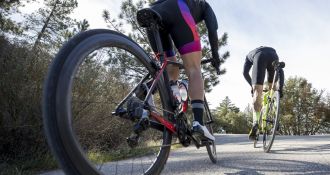
Long climbs, perhaps of the alpine or pyrenean variety, often feature heavily in a cyclist’s new year plans. Riding up mountains by bike is a real test which some thrive on, burying themselves deep in the red, while others simply enjoy the heady and refreshing views experienced from the road as the pedals spin and the legs complain quietly. While it’s possible to train for long sportives in flat countryside, the simulation of long climbs is more difficult. However, there are a handful of ways you can train for mountains without embarking on an expensive training camp.
Hill/sprint/headwind reps
For want of anything better, a short climb or even a strong headwind can be a very useful training tool. Choose a local incline or flat and clear stretch of road and ride it several times. While you don’t get the endurance aspect of the long mountainous climbs, the practise of attacking a small hill over and over again works on fatigued effort. If hills are hard to come by, choose a day with a strong wind, work out which direction it is blowing and ride into it repeatedly in a harder gear than you would normally to simulate the incline.
Intervals
To replicate the sustained effort that a long and relentless climb requires, interval sessions should be a key part of training. After a sufficient warmup, put yourself through a number of intense sessions that should be around 8 or 9 out of 10 in perceived effort. Start with 20 minute stretches and build up to hour long efforts. The key thing to remember is that you’re trying to ride just below maximum for as long as you can so you keep something in reserve. This is also a session that is easy to do on the indoor trainer if you have one.
If you don’t own a turbo, then take a look at our range:
{:39915, 36228, 39122}
Cadence training
Chris Froome is famous for his incredibly high cadence when climbing, typically hovering between 90 and 110 rpm, whereas normal human beings might struggle to get over 70rpm when the road tilts up. It is recognised that a high cadence is more efficient and can make you faster. To make the most of training on the road, we’d suggest a mixture of high and low cadence intervals, both to simulate a gradient and to practise pedalling at a high rate.
If you need a cadence sensor (to pair with Garmin products), you’ll need one of these:
In and out of the saddle
If you’ve ever watched a mountain stage of a Grand Tour in which Alberto Contador is a key protagonist, you’ll likely have witnessed his waltz-like climbing style. He is not unique in his out-of-the-saddle riding, but the time in which he remains in this state is what stands out.
‘El Pistolero’ seems to be able to spend vast amounts of time bobbing around out of the saddle while those around him remain glued to their seats, only getting up to accelerate or release pressure on tender areas. Building the strength and endurance to ride in this way will enable you to maintain your comfort and keep you climbing for longer as you demand different groups of muscles to help out in your ascent skywards. Practise riding out of the saddle whenever possible, drawing it out longer each time. Strength training off the bike, particularly for your arms, will make this technique easier.
Base fitness
Last but very definitely not least, any challenge requires a good base of fitness, so use the early months of the year to ride lots, building endurance and that all-important ability to withstand pain! Recruit a couple of friends, plot a good long route, pick out a cafe for a cake stop, and get on your bike.